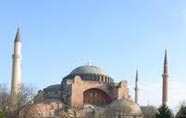|
|
|
.: home .: about us .: news .: sitemap .: contact
us |

|
Home |
 Popularly known as the
strategic place where the 'East' meets the 'West',
Istanbul in Turkey, is a historic and fascinating city,
which bridges the continents of Europe and Asia.
Situated on the west of the Bosporus strait, which is
responsible for joining the Black sea and the Sea of
Marmara, Istanbul has a diverse history that is packed
with tradition and ethnicity of its various conquerors. Popularly known as the
strategic place where the 'East' meets the 'West',
Istanbul in Turkey, is a historic and fascinating city,
which bridges the continents of Europe and Asia.
Situated on the west of the Bosporus strait, which is
responsible for joining the Black sea and the Sea of
Marmara, Istanbul has a diverse history that is packed
with tradition and ethnicity of its various conquerors.
|
|
+ more
|
 The
Hagia Sophia or Ayasofya as it is known in Turkish was
actually a patriarchal Basilica that has been considered
to be an embodiment of Byzantine architecture and also
had the distinction of remaining the largest cathedral
in the world until 1520. Built on the orders of the
Byzantine Emperor Justinian, its interiors were richly
decorated with artistic mosaics depicting various
religious scenes and were supported by massive marble
pillars. The
Hagia Sophia or Ayasofya as it is known in Turkish was
actually a patriarchal Basilica that has been considered
to be an embodiment of Byzantine architecture and also
had the distinction of remaining the largest cathedral
in the world until 1520. Built on the orders of the
Byzantine Emperor Justinian, its interiors were richly
decorated with artistic mosaics depicting various
religious scenes and were supported by massive marble
pillars. |
|
+ more
|
|
|
|
 |
 |
 |
Imperial
gallery
One of the remarkable features that the
Hagia Sophia boasted of was the magnificent
Upper Imperial Gallery with its fantastic
mosaics and marble decorations. The central
part of the upper gallery was reserved for
the Empress and the other women of her
court, who could sit there and view the
proceedings down below in a discreet manner.
As a result it was also known as the Loge of
the Empress. |
Upper gallery
One of the most striking features of the
Hagia Sophia during the Byzantine rule was
its magnificent interiors. The entry to the
nave was by itself quite a majestic affair,
where one was exposed to several descriptive
mosaics above the ornamental doors that date
back to he 9th century. All the walls and
the ceilings of the nave are covered with
inlayed marble and mosaics and altogether it
brought about a bright and colorful
appearance. |
Decorations
One of the greatest surviving architectural
wonders of the Byzantine period, the
spacious interiors of the Hagia Sophia was
decorated artistically with huge marble
pillars, priceless mosaics and other
coverings. Under Justinian's orders eight
Corinthian columns were shipped to
Constantinople after being disassembled from
Baalbek. |
|
|
|







